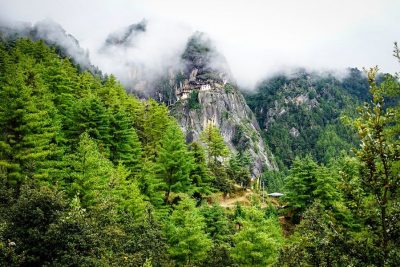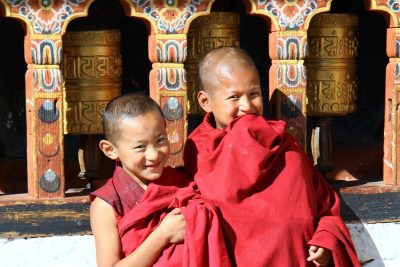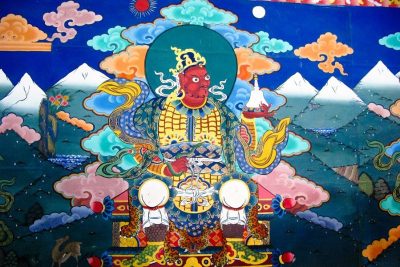The essence of Bhutan
10 Days
ABOUT THE ITINERARY
This itinerary is thought in order to experience the most important sites of Bhutan in a compact tour of only 8 days. Bhutan, unlike its other Himalayan neighbours, considers all creation sacred, including trees, mountains, rivers, lakes and animals. Consequently, some Himalayan species near extinction in the bordering countries of Nepal, India, and Tibet are doing well in Bhutan. Bhutan is also the last bastion of Vajrayana Buddhism, a spiritual practice that is known to be one of the most profound schools of teaching in the Buddhist world. The sacred monasteries, the fluttering prayer flags that line the high ridges, the red robed monks chanting their prayers — all give this kingdom an aura of another time. Even if in a short period of time you will have the chance to discover the best that Bhutan has to offer. The sacred Paro Taktshang, so called Tiger Nest was blessed during 7th century, by the great tantric master, Guru Rinpoche, who came here by his miraculous flying on the back of flaming tigress in form of Guru Dorje Drolo from Khenpajong (eastern Bhutan) on his way from Tibet, to advocate the Buddhism teaching in Mon-Yul (place of darkness). During this itinerary at the discovery of the essence of Bhutan you will have the rare chance of experiencing a full day meditation program with monks in Dongkola Monastry, where for a full day you will live in a monastery together with monks. Moreover, in Thimpu you will discover two of the major organisations involved in education of youth through the teaching of traditional arts.
SIGN UP FOR THE TRIP
Registration can be requested for group travel or for self-travel. For group travel, registration is not binding. Upon reaching the minimum number of members necessary for the formation of the group, usually 4 or 6 people, you will be asked for confirmation of booking and payment of a deposit.
JOURNEY OVERVIEW AND PROGRAM DETAILS
DAY 1: Arrival in Kolkata
Kolkata
Arrival at Calcutta international airport. Transfer to hotel for refreshing and rest. Kolkata, formerly Calcutta, is the capital of the Indian state of West Bengal. Located on the east bank of the Hooghly river, it is the principal commercial, cultural, and educational centre of East India, while the Port of Kolkata is India’s oldest operating port as well as its sole major riverine port. As the former capital of British India, Kolkata retains a feast of colonial-era architecture contrasting starkly with urban slums and dynamic new-town suburbs with their air-conditioned shopping malls. Afternoon short city tour which also includes a country boat ride on the Ganges to experience the glorious sun set.
Overnight in Kolkata (B)
DAY 2: JUNGLE SAFARI IN GORUMARA NATIONAL PARK
Kolkata – Bagdogra – Doars
Early morning flight to Bagdogra. On arrival transfer to a forest resort in Doars. (around 2 hours). Refreshments will be served upon arrival. Check-in to the room, followed by Lunch. Later Embark on an afternoon jungle safari in Gorumara National Park to view some of the wildlife inhabiting the region – one-horned Indian Rhino, Elephant, Gaur (Indian Bison) as well as a variety of endemic and migratory birds. After the jungle safari reurn to the hotel for dinner.
Overnight in Doars (B/L/D)
DAY 3: TRANSFER TO BHUTAN
Doars – Punshotling – Paro
After an early breakfast drive to Phunshotling, the Gateway to Bhutan from India, pass by terraced fields and tea gardens. Here you can purchase souvenirs of their visit from local shop. You can try some local delicacies for lunch in Phunshotling. Here our Bhutanese guide will meet you. Travel to Paro (142km about 4 hrs). Leaving the city of Puntsholing you will heading towards cool and clean air, the road climbs to a higher elevation as you will experience the thin air of the high Himalaya, drive pass Kharbandi Gomba, overlooking the border town of Jaigon and Puntsholing. In a couple of hours drive you will reach Chhukha. There you will see hydro projects, which generates 1020MW of electricity by the Wang Chhu River. You will come across the immigration check point before you climb the Chapcha Village. After crossing the pass, the road drops quickly and follows the upper Wangchhu river, after which your drive becomes much comfortable road till Paro. Check in the hotel and rest
Overnight in Paro (B/L/D)
DAY 4: VISIT PARO
After breakfast drive to Mountain cafe at Paro for refreshment and an orientation for the Bhutan tour by your guide. Maybe you will witness an archery game going on the way to Paro. After lunch drive to Paro Dzong. The Rinpung Dzong (which means fortress on a heap of jewels) was built in 1644 by Zhabdrung Nawag namgyal. From the dzong walk down to the traditional wooden covered bridge.. In the evening a short drive to the oldest and most beautiful Kichu temple, built by Songtshen Gympo in 659. Offer butter lamp in the alter.
Overnight in Paro (B/L/D)
DAY 5: HIKE TO TIGER NEST MONASTERY
Paro
After breakfast start the day with short drive to Paro’s upper valley. On a clear day you’ll have an unforgettable view of the “Goddess” Mt. Chomolhari at 23,640 feet. Afterward, it’s a short drive to Taksang trail head. Hike to Taksang Monastery, the most famous monastery in Bhutan. Taksang means “Tiger Nest” so named because Guru Rinpoche reportedly flew to the site on the back of a flying tiger late in the 7th century. Between blue pines and a blue sky, the monastery perches miraculously on a cliff nearly 2,700feet above Paro’s valley floor. Offer butter lamp here. Have lunch at Takshang Café. Later visit a farm house where you will be able to see various Bhutanese traditional way of making rice wine, the Zaw, the Suja making (butter tea), learn traditional game of Archery and Degor (play with stone). Evening Enjoy a traditional hot stone bath. Back to hotel for a well earned rest.
Overnight in Paro (B/L/D).
DAY 6: MEDITATION SESSION DONGKOLA MONASTRY
Paro – Dongkola Lhakhang – Haa
After breakfast drive (about 2 hours) to Dongkola Monastry where you can meet the monks. There will be an offering and after ceremony visit the main temple. After the ceremony join the monks for lunch and later you can join the monks in temple cleaning activity. Late afternoon you will have a chance to have a meditation session with the monks. Evening drive to Haa via chelala the highest motorable pass in Bhutan.
Overnight in Haa (B/L/D).
DAY 7: VILLAGE WALK IN HAA
Haa – Thimphu
Morning a Bhutanese village walks just nearby Sonam dinzgkha heritage lodge, where you can observe and interact with the villagers while they are farming. Back to Hotel and enjoy an authentic Bhutanese Lunch. After lunch drive to (around 3 hours) Thimphu. Evening Free to stroll around Thimphu.
Overnight in Thimpu (B/L/D)
DAY 8: Depart Paro
Thimphu
After breakfast a visit to CTAS (Choki Traditional Art School) located just north of the capital of Bhutan, in the beautiful mountain valley of Kabesa. Established in 1999, the school trains disadvantaged youth in the traditional skills of drawing, ‘thangka’ painting, weaving, embroidery, sculpture and wood carving. Students live, study, learn skills fortheir livelihood and work in the school, which is a collection of traditional Bhutanese buildings, white painted, on the side of a sunny hill amid farms and villages. Currently 136 girls and boys attend and they range in ages from 15 to 25. Students typically study for six years at the school. Here you will have the chance to interact with students and learn one of the arts. Later part of the day visit the tallest ‘sitting Buddha’ statue, Memorial Chorten, National Animal Takin. In the evening enjoy a Bhutanese cultural dance program.
Overnight in Thimpu (B/L/D)
DAY 9: EXPLORE PUNAKHA
Thimphu – Punakha
In the morning a visit at Vast (voluntary art studio). The goal of the studio is to promote both traditional and contemporary works of Bhutanese art, to provide vocational training for young artists and to act as a creative meeting venue for artists. It’s a great place to plug into the Thimphu art scene, check out the latest exhibit and chat with artists. Some art is displayed in the public park outside. Drive to Punakha takes around 2 hrs on a black topped smooth Road. Enjoy a breath-taking mountain view the Dochula Pass. You can also take walk here at 108 stupa build by Ashi Droji wangmo. Resume Drive to Puankha and before checking in the hotel take a walk through paddy field to Temple of fertility Chimmi Lhakhang (temple), known as the temple of divine madman.
Overnight in Punakha (B/L/D).
DAY 10: DEPART PARO
Punakha – Paro
Morning after breakfast you will transfer to the airport (around 2hr drive). Say goodbye to Bhutan and board a flight for onward destinations.
ACTIVITIES
- Discover the city of Kolkata,
- Enjoy a jungle safari in Gorumara National Park
- Explore the cultural and ecological richness of Bhutan,
- Visit the Rinpung Dzong (which means fortress on a heap of jewels) in Paro and walk down to the traditional wooden covered bridge,
- witness an archery game going on the way to Paro,
- Enjoy an unforgettable view of the “Goddess” Mt.Chomolhari,
- Day hike to Taksang, the famous Tiger’s Nest Monastery,
- Visit a farm house where you will be able to see various Bhutanese traditional way of making rice wine,
- Participate for a full day in the activities of monks in Dongkola Monastry,
- Take part in art and crafts activities in Choki Traditional Arts School,
- enjoy a Bhutanese cultural dance program in Thimpu,
- Discover an art studio which promotes traditional and contemporary of Bhutanese art,
- take a walk through paddy field to Temple of fertility Chimmi Lhakhang temple in Punakha,
- Visit temples and Monasteries.
SOCIAL AND ENVIRONMENTAL IMPACT
All the itinerary has been designed in order to promote direct or indirect benefits for local communities, environment and cultural heritages. When possible, we have selected traditional accommodations sensible to social and environmental issues, following general principles and practices of responsible tourism. For the benefit of local community the Bhutan government decide to open few indigenous village for visitor whilst conserving the natural resources and respecting their way of life, which involves communities to be environmentally sustainable, contribute to the community school, library, also conservation of wild life project. Some of these are contribution to the Gross National Happiness (GNH).
In Thimpu, the capital of Bhutan, the tour will support the CTAS “Choki Traditional Art School”, whose main mission is to preserve the traditional arts and crafts of Bhutan from fading away, and to empower youth with livelihood skills. This school is the only private institute providing training on traditional arts and crafts in Bhutan. It provides free tuition, food and lodging facilities to the economically disadvantaged youth of Bhutan. By teaching and promoting traditional skills of Bhutan the institute has high potential to create new jobs. Zorin Chusum (Thirteen Crafts) can provide a real source of income and employment.
In Thimpu you will also visit a Voluntary Artists’ Studio, known as VAST, which was set up in 1998 by a group of professional artists as a non-profitable and non-governmental organization (NGO). This informal organization was set up with the sole aim of providing an opportunity to the Bhutanese youth to participate and develop their potential talents as well as share social responsibilities through artistic explorations and other socially useful and productive work. Its primary objective is to provide potential vocational skills and alternative positive use of free time and facilitate participation in the national and international art realm. You will have an exposure visit to the youth centenary village, part of “Simply Bhutan”, an unique project of the Bhutan Youth Development Fund. This institution runs programs in order to build leadership skills, encourage teamwork and promote the value of service among youth. Through advocacy work and strategic partnerships, the Fund works to encourage youth participation, raise awareness of youth issues and promote youth-oriented policy. We invest in Bhutan’s future, one youth at a time.
TIPS BEFORE DEPARTURE
A conscious approach to travel requires a considerable capacity and willingness to adapt and adjust to the local environment and culture. If you wish to travel with us we request you to be open enough to experience local culture, religious and traditions without bias and pre-conceived ideas you might have before the departure and which belong to our Western cultural way of thinking. Exploring with fresh eyes, with patience and openness, you will be able to access the real essence of the cultural heritages and spirituality through the places and people you are going to meet; if you are ready to do this effort you will really enjoy the beauty of the rich culture and religiousness of Bhutan, the extraordinary of the nature, the solemnity of Buddhist monasteries and the holy sites blessed by Guru Padmasambhava himself.
In Bhutan the weather could get wet with sporadic or long showers. Please pack appropriate clothing. Bhutan’s changeable climate means you have to bring an assortment of clothes, including rain gear. Mornings and evenings could be quite cold. Carry with you appropriate warm clothing especially for the evening. A layered wardrobe probably makes the most sense. However, warm clothing is required throughout but more specifically from October to April. Good walking shoes or hiking boots are essential even if you are not hiking. Because of the altitude, a hat or cap and a good pair of sunglasses are essential. Because of the long distances between towns and villages bring the medicines you’ll need along with some first-aid supplies. A good flashlight (torch), water bottle and polarizing filter for your camera will also come in very handy. A backpack is necessary to carry essentials/cameras while you are on local excursions. Monasteries and temples are places of worship, so you should be dressed accordingly. Admission might be denied to men and women wearing short pants/skirts, sleeveless t-shirts/blouses.
Getting to Bhutan is not quite straightforward. The Bhutanese Government monitors visitors into and out of Bhutan. On entry into Bhutan, you will meet an official recognised guide, who will escort you everywhere. He will be with you until you depart. You are strongly recommended to engage with us at an early stage of you are planning to visit Bhutan during Festival periods.
This itinerary offers good opportunities for cultural exchange, adventure, hiking, wildlife spotting and moderate trekking. However it is not fit for everyone, due to moderate trekking and altitude. Check with your physician to confirm that you are healthy to travel. Inform your doctor where you are going to see if there are any special concerns. Because of the climate and general lack of medical facilities in the villages, you should be reasonably fit before departure.
HOTELS
In Bhutan, we have selected mid category hotels with all the major facilities and comforts but in the true tradition of Bhutanese hospitality.
TRANSPORT
We will be using comfortable and air-conditioned mini-coach/van throughout the entire trip.
WHEN TO GO
It is possible to visit Bhutan all year around but the best weather is generally:
Mar–May (spring)/ MidSep–MidNov (autumn). Spring (March April & May) is the most beautiful time of the year, resplendent and ablaze with a spectacular array of bright colours. Also, it is the time to witness the famous Paro tsechu festival. The Paro Tshechu is held every spring and is one of the most colourful and significant events in Paro Dzongkhag (district). Autumn (September, October & November) is lovely with clear and crisp blue skies, providing a grand view of some of the tallest unclimbed mountains in the world. It is the best time for trekking and for travelling. This is instead the right time to assist to the Thimphu tsechu festival!




